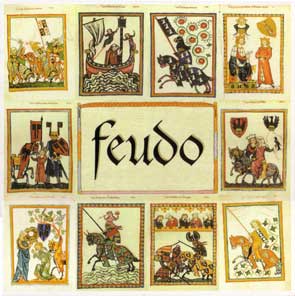Players start Feudo with ten pieces (really chunky cardboard squares) in their castle on one edge of the board (card sections that are flimsy compared to the playing pieces), in striking distance of at least one of the five towns (including Evesham). Players’ pieces are distinguished by their coat of arms and each has its own name. This adds to the flavour of the game, but the heraldry is too small and dark to be easily distinguished if the light isn’t bright. Players also have a set of cards: they select three each turn and play them one at a time. For each card played, they can move the corresponding piece. Players also choose a Trading card to play last. Two of these show coins, which can be used to move pieces again. This is a good way to gain a tactical advantage. However Trading cards are not re-used until they’ve all been played. Choosing the right moment to play their coins is an important decision for players. Once everything has moved, battles take place. These are very simple: if one player has a higher total value of pieces adjacent to an opponent’s piece, the latter is removed. So if I have my Baron (worth 4) and a Knight (worth 3) next to Pete’s First Knight (5), I can defeat it. Unless Pete takes his turn before me, in which case his First Knight can remove either of my pieces. The order of play is crucial to the game. If I move first, I can take the initiative. But if I move last, I can run away. Provided I’ve selected the right cards to play, of course. The order of play is decided by the player in last place, which gives them huge power over the game. As I’ve mentioned, the players get points (the value of the piece) when they remove opponents’ pieces. They also get points for capturing towns (according to the distance between the town and their castle). Towns have their own strength and must be defeated like any other battle. The points for towns can be lost if another player successfully attacks the town later. Players can also lose points for being cowardly! When someone reaches 12 points, the King arrives in the area. Anyone with pieces still in their castle promptly loses the value of these pieces from their points. Players can easily be left with negative scores. The solution is obvious: players make sure they deploy all their pieces in the first few turns. Which usually means that they’re not scoring many points. So there’s a balance to be struck. The other major factor in the game is the Plague. Each turn this moves (probably) across the board from one village to another. It infects any pieces next to the village, reducing their effectiveness (apart from Milady, who can infect other units!). Pieces can recover by visiting the convent in the centre of the board, though this takes time and is not without its own risks. Feudo has some clever tactics, but little strategy. Players could sit back, preserving their pieces to take on the others once they’re weakened. However, this means not scoring any points in the meantime. And each piece that is removed reduces the opportunities to score points. The way the game works means that battles are largely tactical: there isn’t the opportunity to build a large force to dominate the fight. The whole game has this ‘bitty’ feel to it. There are so many special rules (such as Milady’s special ability when she has the plague) and exceptions that make the game hard to learn. All in all, Feudo has some good ideas – and lots of good intentions – but is rather disappointing. Feudo was designed by Mario Papini and is published (in Italy) by Zugames. It is a light wargame for 2-4 players, aged 12+, and takes 2-3 hours to play. It is available from the Zugames website for 39 Euros plus postage and packing.
|
Pevans |
 The 1265 battle of Evesham seems an odd topic for a game from Italy. In fact, Feudo has nothing to do with history, but is a simple, multi-player wargame with a medieval theme. The aim of the game is to gain the King’s favour. In effect, this means having the largest number of points after a set number of turns have been played. Points are scored by eliminating enemy forces and capturing towns.
The 1265 battle of Evesham seems an odd topic for a game from Italy. In fact, Feudo has nothing to do with history, but is a simple, multi-player wargame with a medieval theme. The aim of the game is to gain the King’s favour. In effect, this means having the largest number of points after a set number of turns have been played. Points are scored by eliminating enemy forces and capturing towns.